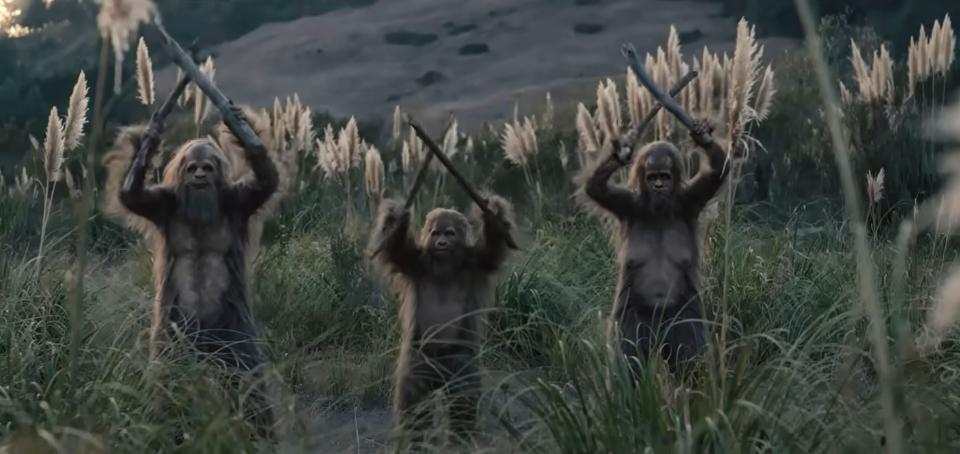Designing the ‘Sasquatch Sunset’ Bigfoot Suits to Withstand Intense Weather

- Oops!Something went wrong.Please try again later.
Typically, when visual effects artist Steve Newburn takes on a project, his involvement is limited to a few key moments or scenes. “For the most part, you’re making an alien on ‘Star Trek’ that shows up for one scene or creating a body for a slasher film,” Newburn told IndieWire. “It’s rare that you’re coming in and doing something that will be in every frame of the movie.” That’s why David and Nathan Zellner‘s “Sasquatch Sunset” was a “bucket-list project,” in Newburn’s words. “We’ll probably never do anything like it again.”
For “Sasquatch Sunset,” Newburn and his team created four Sasquatches to be played by Riley Keough, Jesse Eisenberg, Christophe Zajac-Denek, and Nathan Zellner, all of whom would be in full prosthetic makeup for the entire film. The job immediately sparked Newburn’s imagination thanks to his obsession with a 1980s Spielberg production that had always been a touchstone. “‘Harry and the Hendersons’ was always one of my favorite movies when I was younger,” Newburn said. “It’s always been the pinnacle of what a Sasquatch is in my mind.” For Newburn, the key was to apply the principles of that Sasquatch, whose face was entirely mechanical, to designs that would enable the actors to express themselves underneath the makeup.
More from IndieWire
The first decision Newburn and the Zellners made was to avoid giving the actors contact lenses. “We were going to be seeing so much emotion through the eyes,” Newburn said, “and we were also out in the elements, which would have made contact lenses a nightmare.” Working with Nathan (then the only actor cast), Newburn came up with a design based on Zellner’s proportions and features. Once the other actors came on board, head casts were created, and Newburn’s team sculpted the makeup onto those, adapting their initial designs to each actor’s specific features. Because allowing for maximum expressiveness was paramount, Newburn kept the prosthetics as thin as possible. “They’re about an eighth of an inch, so the features of the performer can show through, and they can move them as much as possible.”

One of the biggest challenges for Newburn was making sure the makeup would hold up under adverse weather conditions, since the entire film was shot on location in remote woods. “There were no stages,” Newburn said. “Everything was out in the middle of nowhere in Northern California. We were on privately owned land that belongs to the logging companies, who just buy up millions of acres and let them sit there for 50 years because they want trees to grow. We were getting into parts of the forest where the public isn’t allowed to go, so it’s real nature where everything is overgrown.”
That meant Newburn and his team had to carefully maintain the suits to withstand whatever conditions would be thrown at them and create multiple prosthetic pieces — somewhere around 120 sets. “There would be a moment where we’re going to throw Jesse in a river, but the river is 37 degrees Fahrenheit. Usually, you build a creature suit and say to the person wearing it, ‘Hey, take care of this thing, don’t abuse it,’ but in this case, we were doing the exact opposite — ‘Go roll around on those rocks, go jump in that river.'”
Adding to the degree of difficulty was the fact that, although Newburn worked on the movie off and on for several years, when the financing finally came through, his prep time was extremely abbreviated. “Normally for something like this, we’d spend three or four months prepping, and we had about six weeks,” Newburn said. Although in many ways “Sasquatch Sunset” was the most challenging job Newburn has ever had, he’s quick to insist that it’s also the most rewarding. “It’s a unique vision and a unique film, and I’ve wanted to make a Sasquatch for 30 years. So when they called me about it, I just said, ‘Tell me what you can afford to do, and I’ll make it happen.”
Best of IndieWire
The 28 Best True Crime Shows Streaming Now, from 'Under the Bridge' to 'The Vow'
The 10 Best Doppelganger Films, from 'Dead Ringers' to 'Vertigo'
The Best Cannibal Films of All Time: 'Silence of the Lambs,' 'Raw,' and More
Sign up for Indiewire's Newsletter. For the latest news, follow us on Facebook, Twitter, and Instagram.

